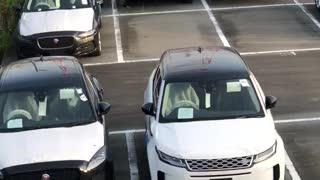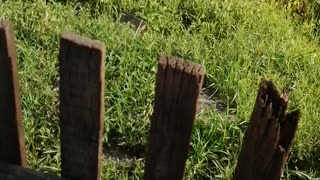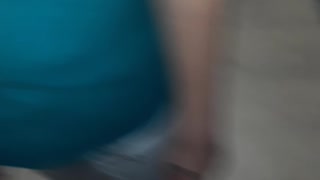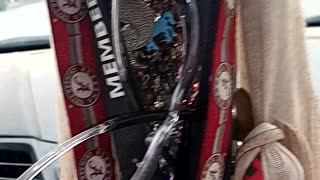The abandoned cats in Malaysia were starving and cold
Kuching is the capital and most populous city of the state of Sarawak, Malaysia. Not many people know about the reason Kuching city is named after a cat, mostly legends and judgments. The image of cats is deeply embedded in the life of the city, from history to culture and modern life.  Cats are everywhere in Kuching. Photo: Grant Dixon In Kuching, you can see cats everywhere. From the airport to the city, right on the detour outside Chinatown, a giant white cat waved to visitors. On the sidewalk near the mosque, a family of robotic cats stared at passersby. Street art cat statues are decorated with spray paint around the buildings. Located north of Kuching City Hall, the Cat Museum is the most special place in the city if you want to learn about cats and their connection to the city on Borneo island, which is famous for. sound with orangutans. Amir, who works at the Cat Museum, said: "The obsession with cats in this place stems from the name of the city. The word ‘kucing’ means ‘cat’ in Malay ”. Standing next to the numerous exhibits depicting the 5,000-year history of the cat, Amir has explained some of the theories behind the birth of the name "Kuching". Some believe that when the first Prince of Sarawak, an Englishman named James Brooke, arrived in Kuching around 1839, he pointed to the settlement and asked for the name of the place. A local man thought he pointed to a passing cat, so ‘Kucing’ replied. Others claim that the city is named after the tree that was once planted there. The fruit of this tree is ‘Mata kuching’, which means ‘Cat's eye’, it closely resembles lychee. The final theory for the unique name of the city is that it was placed when people discovered a species of short-tailed cat that lived along the banks of the Sarawak River flowing through the city.  The Cat Museum north of Kuching City Hall features the 5,000-year history of cats. Photo: Esme Fox Kuching is a multi-ethnic city inhabited by Malays, Chinese, and Indians, as well as local tribes such as the Iban, Bidayuh, Orang Ulu and Melanau. Cats carry important meanings to every group of people living here. For the Chinese, for example, the cat is a symbol of luck. For hundreds of years, cats have also been cultivated by Muslims - the dominant form of religion among the native tribes of Borneo. The prophet Muhammad had a cat named Muezza. Residents on Borneo Island love cats because they help control insects. In the 1950s, the government used chemicals to kill mosquitoes and mice that carry malaria. After these chemicals adversely affected cat populations in the area, the Royal Air Force carried out a mission called "Operation Cat Drop", releasing 14,000 cats into the countryside in Borneo, Malaysia. The image of cats is ingrained in the life of this city. The giant colorful cat family statue on top of the fountain, mischievous cats are cast in bronze along the riverbank ... just what you see easily. There is also I-CATS - Sarawak International College of Technology - or Cats FM - Local radio. The highest point in the city, on a high pillar is the balance of justice and a golden cat, with four white cats below.  The Chinese in Kuching believe that cats bring good luck. Photo: Andrew Watson If you want to meet real cats, you can stop by Meow Meow Cat Café, near the Sarawak River and more than 5 km south of the Cat Museum. Owner Janet and the founders thought that they had to open a cat cafe for those who could not afford to keep cats at home. "We currently have 6 cats of different breeds of cats," she said. Here you will find guests playing with different breeds of cats such as the large Kiwi with white fur; Suria, a regal Bengal cat; Honey, a big round Persian cat or a gray long haired cat named April.😊😊
-
 0:30
0:30
Huynhduong111
3 years agoAbandoned cats in malaysia
591 -
 1:53
1:53
Buzzvideos - EN
3 years agoDoting dog takes care of abandoned cats
341 -
 0:33
0:33
Thuong3728
3 years ago $0.01 earnedabandoned supercar
156 -
 0:29
0:29
fomicheva4555
3 years agoAbandoned garden
82 -
 0:04
0:04
CycloneScrapper
3 years agoAbandoned bunnies
60 -
 0:20
0:20
JenniferMandeville94
3 years ago $0.02 earnedAbandoned Mental Hospital
711 -
 14:36
14:36
UrbaneSalvage
3 years ago $0.01 earnedAbandoned Restaurant In Chicago
936 -
 1:25
1:25
midknightsangel
4 years agoAbandoned hospital
80 -
 2:08
2:08
WXYZ
4 years agoResidents in Highland Township concerned over evicted family's abandoned cats
15 -
 1:25
1:25
KGTV
3 years agoFire engulfs abandoned home in North Park
30